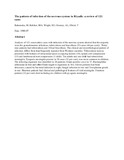| dc.description.abstract | Analysis of 121 consecutive cases with infection of the nervous system showed that the majority were the granulomatous infections, tuberculosis and brucellosis (53 cases (44 per cent)). Thirty-nine patients had tuberculosis and 14 had brucellosis. The clinical and microbiological pattern of infection differs from that frequently reported from Western countries. Tuberculosis lesions presented with features of intracranial space occupying lesions (14), spinal cord compression (13) and lumbosacral root compression (1 child). Ten adults and one child had tuberculous meningitis. Pyogenic meningitis present in 38 cases (31 per cent), was most common in children. The infecting organism was identified in 26 patients; Gram-positive cocci in 17, Haemophilus influenzae in four and other Gram-negative organisms in five. Eleven patients had brain abscesses, caused by bacterial infection in eight, fungal infection in two and Toxoplasma gondii in one. Nineteen patients had clinical and pathological features of viral meningitis. Fourteen patients (12 per cent) died including six children with pyogenic meningitis | en |

